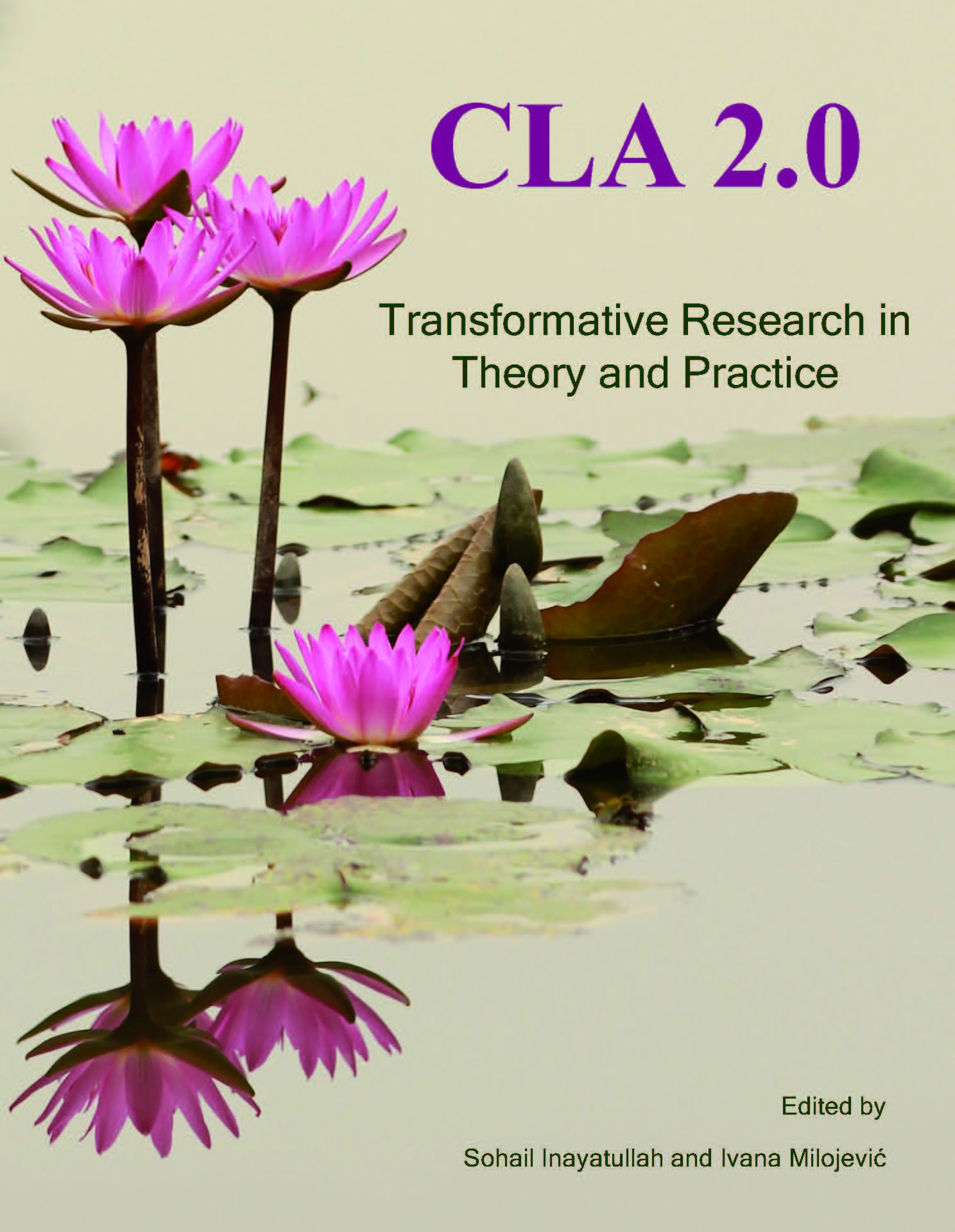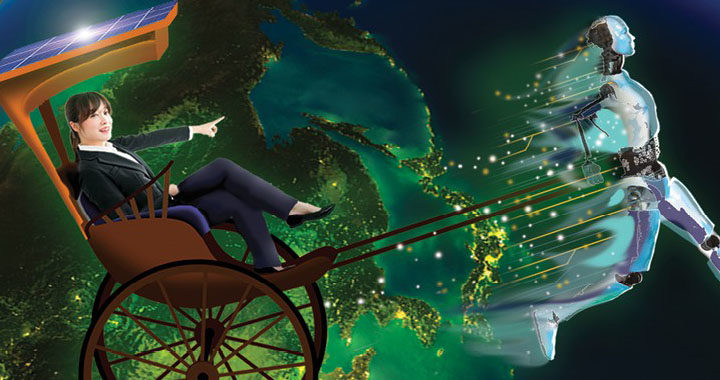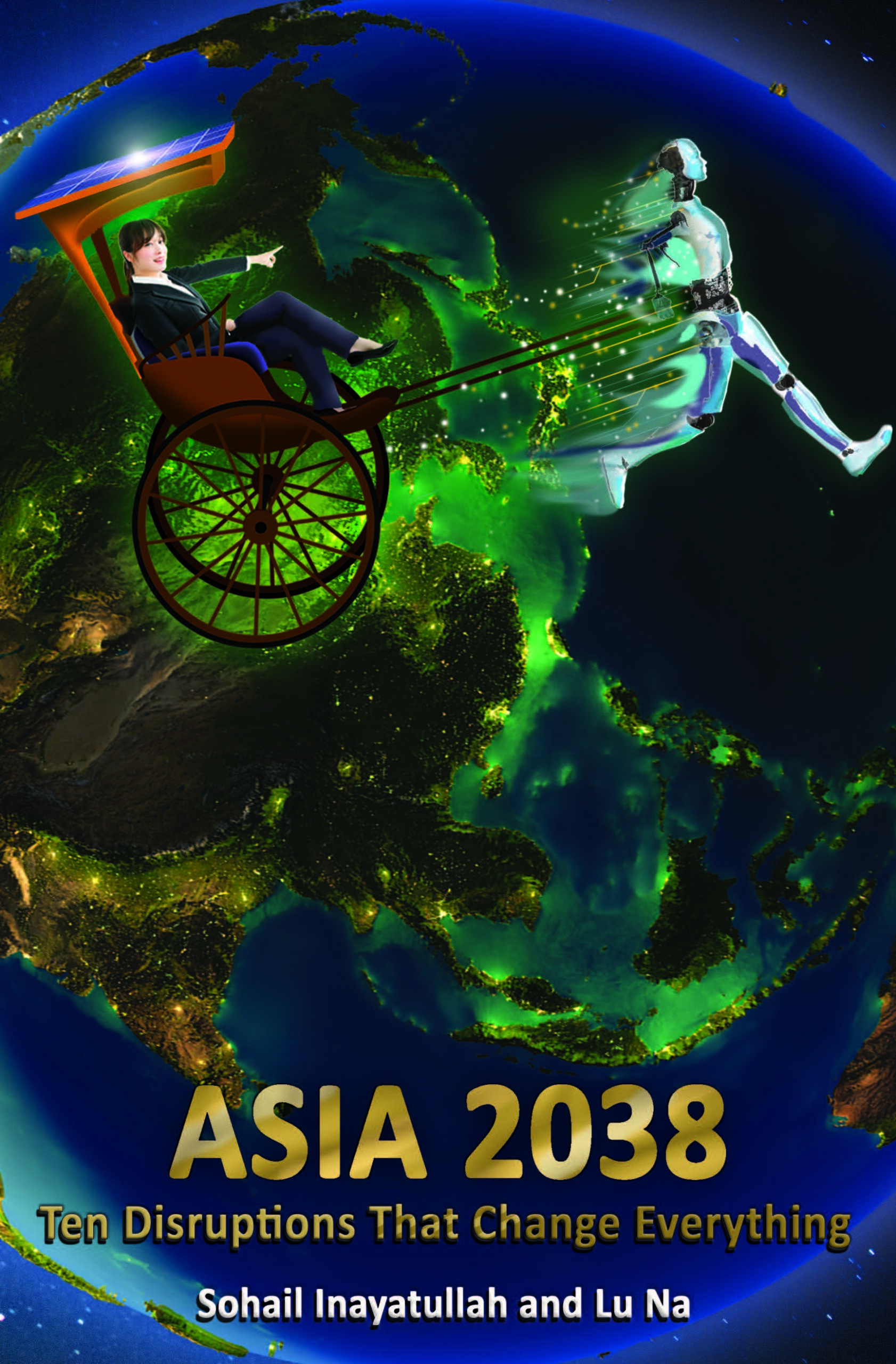By Sohail Inayatullah
“Five Futures for Muslims,” http://www. futurebrief. com/Sohail. asp. August 11, 2004. Refereed Web Journal.
Abstract
Five alternative futures for Muslims are explored in this essay. In the first, the Islamic world attempts to return to its historical memory of grandeur. As this return is not a contextual return but a reiteration of the conditions of the 7th century, a medieval feudal Islam gains supremacy. For most Muslims, this is decline. In the second possible future, divisions within the Islamic world heighten. War with the West, among Islamic nations, and among sects in Islam is primary. This is a slow, but potentially dramatic decline. In the third, Islam follows a linear trajectory, becoming part of the modern secular world. In the fourth, Islam and the West undergo pendulum shifts, as one declines and the other rises. The final future is a “virtuous spiral” that imagines not only an alternative modernity for the Islamic world, but an alternative global future. Pluralism within Islam and within the world system is fundamental. As a result, Islam becomes part of a planetary ethic of ecology, gender partnership and global governance – the solution to the global crisis of meaning, sovereignty, and politics.
The Perfection of the Past
When the future of Muslims is discussed,2 whether by mullah, political leader, or believer, most tend to resort to the historical memory of the time of the rightly guided caliphs, when the Prophet’s principles of moral leadership and shura (deep consultation with the believers) were practiced.
It is this past – a living prophet with a geographically bounded state – that remains the vision of the future for many Muslims. In this sense, one can paradoxically argue that Christians were more fortunate that Jesus did not succeed (during his time) in creating a Christian state.³ The fact that a utopian Christian state never existed allowed room for ideas of future state systems, a notion of progress, and a movement toward a better future. Of course, the religious dimension of this has become the search for the savior – the return of Christ. But by and large, it has been capital coupled with technology in the context of freedom of the individual that has been the driving force in the West.
For Muslims, the past attainment of a perfect or near perfect Islamic state and society may not have been the blessing it is often assumed to have been. Social and political “progress” has focused on returning to the ideal-perfect era. As well, social and technological innovations have become limited as many Muslims have tended to make the fundamental error of “misplaced concretism.” That is, the details of the earlier epoch are re-engineered – the strong warrior male leader, the hijab for women, the battle of good and evil, tribal politics, and other particulars of 7th century life. This period is taken out of history and decontextualized. Instead of focusing on a productive future, concrete dimensions of the past are re-imagined. They are brought back and used as tools for social control, particularly against the most vulnerable. Traditionally this memory of an idealized past was used for nation-building, but now it is used as part of the larger quest to create a modern Khalifate – an integrated empire.4
Divided Islam, Divided World
While the first future is driven by the desire to return to tradition, the next plausible future is based on the playing out of various contradictions – these include civilization and nation, and civilizations5 in conflict.
The first tension is between Islam as a civilization and Islam within the nation-state; that is, one cannot have, by definition, an Islamic Republic of Pakistan. Islam must be free of all national shackles. It is this contradiction that worries leaders throughout the Islamic world – in a true Islamic Khalifate they would no longer have power. This is the same fear that American leaders have of the United Nations. Super-ordinate power is a threat to local power, even if it is more appropriate for economies of scale, policy implementation, the environmental challenges facing the planet, and for global peace keeping.
Can a “Pan-Islam” be created, or will the tensions between civilization and nation-state always exist? Or is it possible that there is a way out of this dichotomy? The last scenario at the conclusion of this essay, that of the virtuous spiral, explores a way out.
The second tension is between Islam as a civilization in conflict (and for many historical periods in harmony) with the Judea-Christian world. By most measures, the Islamic world falls short on most economic and social indicators.6 Yet, Muslims and Westerners offer very different explanations for these shortfalls. From the Western perspective, the Islamic world has failed to modernize, secularize, and innovate. Nations are like individuals, and Muslims have not followed the dictates of Adam Smith et al. The Islamic response, however, is focused less on internal issues and more on external ones – principally, how the West has intervened in the Islamic world’s natural development. From this perspective, colonialism has created an economic and social straitjacket, reducing the pathways possible, often with violent results. Thus, the grand and often polemical calls for justice from the Islamic world. But the shadow dimension of this broad definition of justice (the righting of endless historical structural wrongs) is conspiracy. In the minds of some, there are always malevolent actors from evil civilizations at play. For many, this is what explains the decline of Muslims. Not just amoral economic patterns but actors actively plotting the decline of Islam (since it represents the fundamental threat to the Western world, similar to communism in the 20th century). And there are collaborators within as well – the overly westernized Muslims, women and corrupt leaders (and the less than true believers).
The future of Islam cannot be divorced from that of the rest of the world. If the world remains unfair in Islamic eyes – war on Iraq but not on other violators of human rights, on other despots in Russia or China as examples – then the sense of injustice and powerlessness remain. Moreover, as C. Inayatullah of the Council of Social Sciences in Pakistan argues, this injustice serves as a vehicle to unite Muslims.
With the assumption that the current world order based on culture of conflict, violence and war persist, Muslims will act within it and respond to its violent aspects with greater violence. [In this future], Muslims will become more fundamentalist and develop greater unity among them to face the rest of the world and fight their battle under the banner of orthodox Islam [the past-based future].7
In this violent future, the Islamic world will certainly lose in the short term. Any violence committed against the USA and European nations will be met with further violence, not with calls for dialogue. Mediation between Bin Laden and Bush and their respective successors simply is not in the cards. Violence will lead to more violence, and the hard side of Islam (an eye for an eye, the world divided clearly into good and evil with violence justified) will be dramatically defeated, given the asymmetry of wealth, technology and aspirations (the desire of those in the Islamic world for a predictable and safe middle class existence).
After the defeat (and even perhaps simultaneously), the medium term – 50-100 years – will see the rise of the softer syncretic Sufi side. However, deeper issues will still not be resolved since it was violence instead of productive peace building (internal and external) that drove the changes within Islam. As a result, the cycles of poverty, alienation, and despair will continue within the Muslim World.
Thus, in the long term, future generations will remember their defeat and the calls for justice will spring up again. Just as the Crusades remain ever alive for Muslims, 9/11 will be lived out every few hundred years – with even more violence.
For the West, the short term victory will only make matters worse (once the virtual ticker tape parades are over). This is because it is partly in conflict with its own self-image and the cost of victory will be the rejection of its softer multicultural self. Victory will create a security-surveillance state that will limit its capacity to innovate.8 Its claim for moral legitimacy will be challenged. Just as the Abu Ghraib prison crisis is explained by those in the Islamic world, not as managerial errors – a few bad eggs – but as a combination of Empire (expansion of power), Orientalism (Iraqis are genetically and culturally inferior) and the Prison discourse (prisoners should not have rights – the world is dangerous). Attempts to create far more effective and efficient prisons will not solve the problem (nor will attempts to reduce access to digital cameras) as the solution to cultural crisis is rarely technocracy.
This second alternative future does not bode well for Muslims or the rest of the world. It too ends up focusing on the past – idealized perfection and historical injustices on one side, and blindness to cultural hegemony on the other.
So far we have explored two futures: The first attempts to return to the imagined past, wherein medieval feudal Islam gains supremacy. However, as this future swims against the modernist and dominant Western stream, conflicts worsen with the West. The second possible future entails continued war with the West, and within Islam as well (the inner pluralist soft and extremist hard), leading to decline and degeneration. In effect, the outcome of these two futures is the same: conflict and decline.
The Linear Ascent
The third potential course for Islam is the linear trajectory. Islam, with fits and convolutions, and minor reversals, will follow the Western trajectory. After all, Muslims like Christians and Jews are the children of Abraham. Islam’s temporal future is predictable. Muslims will emerge from the medieval era and enter a modernist one. At the level of the nation-state, Turkey or Malaysia serve as models of the likely future. Of course, there will be Iranian-style backslides, but eventually the power of the ayatollahs will diminish. This is the American vision – that Jeffersonian democracy along with its invisible hand will triumph, individual human rights will be recognized as universal, and all cultures will eventually discover what is authentically good for them. The European version is similar, but based more on enforceable global institutional regulatory regimes.
The Islamic world will thus leave its medieval paradigm behind and join the European enlightenment (or create its own similar version). Just as the West went from
from ancient to classical to feudal to modern and now is entering a period of unlimited choice and the boundary-lessness of postmodernism (challenging stable notions of truth, nature, reality and self through robotics, genetics, space travel, feminism, multiculturalism), the Islamic world will also leave the feudal and enter the modern. The current crises, seen from a long term macroview, are minor reactions to this predestined trajectory.9
However, seen with far less of a grand vision, the march into a linear shared global future continues to have major setbacks. First is despotism within the Islamic world, even in Malaysia with the arrest and torture of Anwar Ibrahim, the former Deputy Prime Minister of Malaysia . Second are the events of 9/11. Third has been the continued violence in Palestine/Israel.10 Fourth, are the divisions of class and gender, and the urban patterns of poverty, alienation and disempowerment found in the Islamic world.
Outside of the Islamic world, equally relevant are the following factors: First is uneven globalization, with few immediate and mid-term benefits to poorer nations. Second is the continued perceived hypocrisy among the Western powers. When they are not walking the walk, as with the Abu Ghraib crisis (where hypocrisy was hidden behind managerialism instead of the apology of honor, so fundamental in feudal and indigenous cultures). Third is Orientalism, the cultural construction of the non-West as inferior – that is, direct, structural and epistemological violence. And, fourth is hyper-technological advancement via robotics, genetics (from gene therapy to germ line intervention), and nanotechnology that make catch-up practically impossible.11
In this vision, the Islamic world’s future is contoured by the Rise of the West, from colonial empire to developmentalism and now to globalization (with hints of Empire next). The Islamic world’s trajectory is defined and limited by the West’s technological, economic, political and definitional dominance,
Along with restricted parameters, there is temporal contagion within this trajectory and thus we see Bin Laden and his cohorts simultaneously as feudal warriors – a clear leader, clan, relationships, honor – and as globalists and even “netizens.” As well, these forces live in conflict with modernist leaders and bureaucrats focused on a secular rational institutionalized industrial state formations who are in tension with citizens living in multiple worlds – the scientific, the feudal, the secular, the modernism and indeed the postmodernist. New technologies exacerbate the possibility of enhanced multiplicities – CDROM, the web – all remove the power of interpretation from mullah to individual, allowing for far more individualized religiousity.12 This possibility of more individualism is unsympathetically understood by Bin Laden type traditionalists (even while they use the tools of global technocratism) and national bureaucrats, who paint all attempts of individualistic and syncretic Islam as unpatriotic. He who owns the means of knowledge, the right to define, is at the heart of the battle within Islam, and indeed, the world. And it remains the West, particularly the USA, that is the defining agent.
Thus, the linear trajectory is far more difficult when there can be only one “king of the hill.”
A fourth future is the replacement of the King of the Hill. Instead of linearity, the shape of the future may be swing of the pendulum.
A Pendulum Shift
A pendulum swing is the fourth possible future for Islam. If the West enters into decline, caused partly by aging (witness the demographic destiny with Caucasians moving from 50% of the world’s population in the 1850s to less than 5% by 2150), Islam will be on the rise (especially if it can move away from conspiracy to innovation). In this formulation, both West and Islam are in the same field, facing each other with antagonism and fear, but still part of the same unitary relationship. If the West declines (perhaps due to imperial over-reach, global warming, failed genetic experiments, or an inward looking security state), it may be Islam that rises to fill the world vacuum, as macrohistorian Johan Galtung has argued.13 While China, and possibly India, are the most likely candidates for world hegemony, Muslims could use the current crisis to move away from extremism and recover the spirit of tradition without its negative details. Thus, they could step into a vacuum and provide the ethical anchor to the relativism of postmodernism.
A Virtuous Spiral?
This recovery of the past in the context of future-oriented progress – the virtuous spiral – becomes the final scenario. This future is the most hopeful for Islam and the rest of the world. In this alternative trajectory, after a brief foray into postmodernism – endless consumer choices but no ground of reality – a new global ethics may emerge. This is a soft, multicultural Islam engaged in dialogue with the West and East Asia, confident of its dignity, creating an alternative science like that imagined by leaders such as Anwar Ibrahim.14 Many of Islam’s ideas – environmental protection, concern for poverty, Islamic economics, Islamic science (far less cruel to animals, focused on research on the issues of poor and the needy, not just on the issues of the rich) will become part of the global agenda.
Islam’s spiritual history, far less challenged by modernity – coming after the West’s entry into it – will be far less problematic (secularism will no longer be the benchmark of the good society) and will help in the creation of a post-postmodern era, a post-scarcity, spiritually balanced society with deep sustainability.15 This is progress with history, an alternative modernity that offers multiple trajectories leading to sustainable development. To create this future a creative minority is needed. The current hijacking of Islam is the shadow response to the paucity of a creative minority. The creative minority offers a new image of the future and practices it. Groups in the USA (Progressive Muslims) and in the UK are working on this and, hopefully, this can become part of a reformed Islam. Indeed, this was a desired image of the future at an international meeting of Muslim scholars16.
Five points were fundamental:17
- An alternative economics to world capitalism
- Cooperation between the genders based on dignity and fairness
- Self-reliant ecological communities
- Use of advanced technologies to link these communities
- A world governance system that is fair, just, representational and guided by wise leadership
This virtuous spiral model, using aspects of the past to invent an alternative future, is something to be aspired to. The pivotal here, as Zia Sardar argues, is that a reformed Islam can not only transform Muslim society and Islamic thought, it can also provide a genuine alternative to the dominant mode of doing things globally.18
A Dream?
Can Muslims create a new future? Do they have a choice? Can a creative minority envision it? If not, I fear a civilizational, national and local bloodbath which will only create calls for more justice, Israel-Palestine writ large on the world. While many Muslims hope that demography is destiny (and some in the West fear this) 19– Muslim birthrates continue upwards, with some forecasters even predicting that a majority of US Marines will be Muslim by the end of this century20– numbers without qualitative change only lead to even grander decline.
I dream of the virtuous spiral vision of the future. Transformed Muslims and a transformed West, beyond the uni- and the multi- to a transcultural. This future is certainly not probable, but it is still possible.21 And while it is a dream for now, is there really any choice?
Notes
- I would like to thank Bob Adams, Lewis Grow and Ivana Milojevic for extensive comments on earlier drafts of this essay.
- Here seeing the world within the lens of Islam, that is, Islam is eternal and thus not open to discussion on its future, but Muslims, their faith, their behavior, can be analysed, openly discussed.
- See Abdelwahab El-Affendi, Who Needs an Islamic State?. London , Grey Seal Books, 1991, 37.
- In this, both neo-conservatives and the majority of Muslims focus on Empire. The former imagines a USA empire, while Muslims imagine an Islamic empire.
- This piece is fraught with the problems of essentialism: civilizations, nations, and even terms such as Muslims and Christians can be problematic. Identity is not merely given but made in context: whether an archetypal “civilizational” context, or a local identity context (one gains an identity through interaction with another). However, civilizations too can challenge post-structural constructivism, asserting that identity is given and notions of choice privilege certain epistemological perspectives. Finally civilizations are lived; defining them freezes them.
- UNDP Human Development Indicators (created by the Pakistani muslim Mahbub al Haq) is the best report on this.
- Email, April 5, 2004. Dr. C. Inayatullah.
- Not to mention challenge the “melting pot” story.
- For more on this, see “Islamic Responses to Emerging Scientific, Technological and Epistemological Transformations,” Social Epistemologies (Vol. 10, No. 3/4, 1996), 331-349; and earlier in Islamic Thought and Scientific Creativity (Vol. 6, No. 2, 1995), 47-68. Also: “Global Transformations,” Development (Vol. 40, No. 2, 1997), 31-37.
- Justified or not justified (Kashmir, Chechnya)
- In 1993 just 10 countries accounted for 84 percent of global research and development expenditures and controlled 95 percent of the US patents of the past two decades. The die is cast, technocracy will further create a divided world, with the right to the Net and the right to genetic therapy and modification becoming the battle cry of coming decades.
- Sohail Inayatullah and Gail Boxwell, eds., Islam, Postmodernism and Other Futures., 89-106.
- Johan Galtung, “On the Last 2,500 years in Western History, and some remarks on the Coming 500,” in The New Cambridge Modern History, Companion Volume, ed. Peter Burke (Cambridge: Cambridge University Press, 1979). See as well: Johan Galtung and Sohail Inayatullah, Macrohistory and Macrohistorians. Wesport,Ct, Praeger, 1997.
- See special issue of Futures. Anwar Ibrahim, “The Ummah and Tomorrow’s World,” Futures (Vol. 23, No. 3, April 1991), 302-310. Also see: Anwar Ibrahim, The Asian Renaissance. Singapore, Time Books, 1996.
- See www.islamicconcern.com/fatwas.asp for a site on Islam and vegetarianism.
- Organization of Islamic Conference.
- Sohail Inayatullah, “Leaders envision the future of the Islamic Ummah,” World Futures Studies Federation Bulletin (July 1996), Coverpage.. See, Sohail Inayatullah, “Futures Visions of Southeast Asia: Some Early Warning Signals,” Futures (Vol. 27, No. 6, July/August, 1995), 681-688;
- Email . April 2, 2004 . Ziauddin Sardar.
- Recent headlines of Welsh actor, John Rhys-Davies, fearing that the demographic rise of Muslims will lead to a catastrophe for Western civilization, are indicators of much more to come. However, a voice of sanity has prevailed in this discussion. In response to Rhy-Davies comments of Muslim growth in Holland, were the comments Chief executive of the All Wales Ethnic Minority Association (Awema) Naz Malik. He said: “I do not know why he has said these things. If 50 per cent of people in Holland under 18 are Muslims in 16 years time, so what? In Britain the fastest growing race is mixed race, people of dual heritage. It is a cause for great celebration that our cultures are mixed. We live in a global society – we celebrate what is good in cultures and challenge what is bad in civilisations.” But this appears to be a lone voice. For a site taking a strong anti-multiculturalism view.
- Ayeda Husain Naqvi writes in “The Rise of the Muslim Marine” (NewsLine, July 1996, 75-77) that while hate crimes against Muslims rise all over the world, surprisingly the US military is one of the safest places to be a Muslim. Indeed, Qasem Ali Uda forecasts that in 20 years, 25% of all US marines will be Muslim. Given the incredible influence that former military personnel have on US policies (i.e., a look at Who’s Who in America shows that military background and law school education are the two common denominators on the resumes of America ‘s most influential people), inclusion is the wisest policy. The data is far from certain though. Todd Johnson, in his article, “Religious Projections for the next 200 Years” along with scenarios titled “non-religious growth” and Asians opt for secularization while certainly having one scenario as “Muslim revival.” Indeed, with postmodernism on the rise, individuals could choose alternative identities, being far less focused on the traditional, like father, like son. i.e., religion becomes one choice among many. (http://www.wnrf.org/cms/print_next200.shtml)
- For an excellent articulation of this, see Johan Galtung, Globalization for Peace and Development. www.transcend.org. August 2004.




